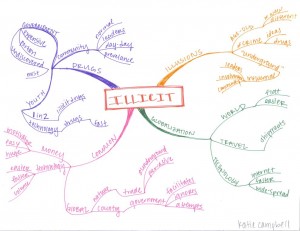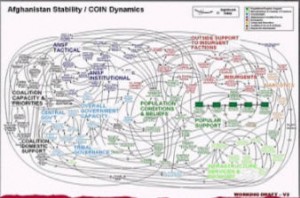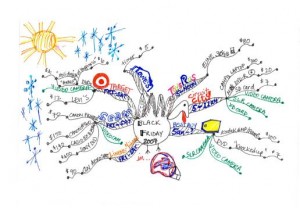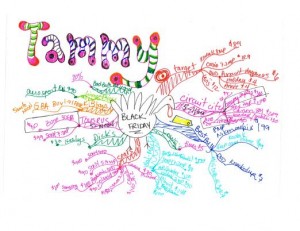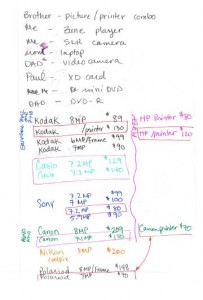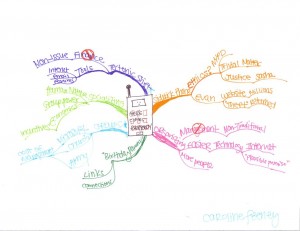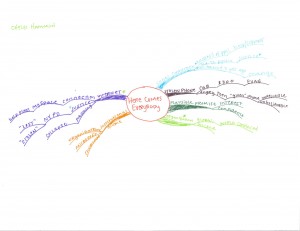An Idea Mapping Success Blogs Weblog
Idea Mapping Experiment at Luther College [Part 7] – Idea Maps #206-207
10 Dec 2009 Author: Jamie Nast In: Book Reviews, Idea Mapping Example, Mind Mapping Examples, SurveysThese Idea Maps are the 13th and 14th examples in this year’s experiment following students at Luther College in Decorah, Iowa. The October 23, 2008 posting first introduced this series and the October 28, 2009 post puts this experiment in context. Read those postings for background.
Today’s idea mapping examples come from students Abby Switzer (top) and Andrew Sloan who both provided their reflections on the book Managing Humans by Michael Lopp in the form of an idea map. Abby’s first contribution to this blog can be seen here.
Thank you to Abby and Andrew for sharing your examples.
Remember: If you are a project manager and have either considered taking the PMP exam, are in the process of studying for it, have passed the exam, or gave up on the whole process — this is your chance to share your experience in this survey which takes less than 10 minutes. As a “thank you” please enter the drawing for free Amazon gift cards or an autographed copy of Idea Mapping by Jamie Nast. Full story here.
Currently Teaching a 2-Day Idea Mapping Workshop
8 Dec 2009 Author: Jamie Nast In: Certified Idea Mapping Instructors, Idea Mapping Conference Events, Idea Mapping Workshops, Joe Kovach, Kaizad Irani, Larisa Brigevich, Liza Seiner, mind mapping workshopsA new group of mind mappers and idea mappers are in the middle of their second day of this exciting workshop taught in Palm Beach, Florida by Jamie Nast. I will post follow-up stories and photos after the workshop.
The first 2010 public Idea Mapping Workshop will be held in Vancouver, B.C. January 19-20, 2010. Register today!
Remember: If you are a project manager and have either considered taking the PMP exam, are in the process of studying for it, have passed the exam, or gave up on the whole process — this is your chance to share your experience in this survey which takes less than 10 minutes. As a “thank you” please enter the drawing for free Amazon gift cards or an autographed copy of Idea Mapping by Jamie Nast. Full story here.
Idea Mapping Experiment at Luther College [Part 6] – Idea Maps #204-205
6 Dec 2009 Author: Jamie Nast In: Book Reviews, Idea Mapping Example, Mind Mapping ExamplesThese Idea Maps are the 11th and 12th examples in this year’s experiment following students at Luther College in Decorah, Iowa. The October 23, 2008 posting first introduced this series and the October 28, 2009 post puts this experiment in context. Read those postings for background.
Today’s idea mapping examples come from students Katie Campbell (top) and Justin Hoffman who provided their reflections on the books Illicit by Moises Naim and Group Genius by Keith Sawyer in the form of an Idea Map.
Katie’s Initial Comments About Idea Mapping: “Idea Mapping was fairly easy for me to learn. I really like the concept of visually representing ideas; although, I think that it is only very useful in certain situations. For example, when I am listening to someone speak or I am taking class notes, I would much rather create a list or an organized, linear form of notes. But when I am brainstorming, summarizing, or trying to condense a large concept, idea mapping worked great.”
Thank you to Justin and Katie for sharing their examples.
Idea Map #204 – The White House’s Afghanistan Battle Plan
3 Dec 2009 Author: Jamie Nast In: Idea Mapping Example, Mind Mapping ExamplesLast night on the Rachel Maddow show, Rachel stated people will see this example of the Afghanistan battle plan (known as the “Planistan”) as genius because the entire plan is shown visually on one piece of paper. So Idea Mapping and visual thinking have made it to the White House! This Joint Chiefs of Staff document illustrates the daunting complexity of this issue — exactly one of the many benefits of Idea Mapping and visual communication.
This map of the stability plan highlights how to gain popular support, governance, development, security, and information systems. Thank you to April Scarlett who attended my Idea Mapping Workshop with the Saline Leadership Institute two weeks ago for bringing this to my attention.
Earn a Chance to Win an Amazon Gift Card or an Idea Mapping Book
30 Nov 2009 Author: Jamie Nast In: Messages from Jamie, SurveysIf you are a project manager and have either considered taking the PMP exam, are in the process of studying for it, have passed the exam, or gave up on the whole process — this is your chance to share your experience in this survey which takes less than 10 minutes. As a “thank you” please enter the drawing for free Amazon gift cards or an autographed copy of Idea Mapping by Jamie Nast. Full story here.
Idea Mapping for Black Friday Christmas Shopping
27 Nov 2009 Author: Jamie Nast In: Idea Mapping Example, Mind Mapping ExamplesTammy Sookthis has participated in both the 2-day Idea Mapping Workshop and the 1-day Memory/Speed Reading Workshop offered through ACH (subsidiary of Ford). Last year she sent me this series of idea maps which she created to get organized for her Black Friday shopping spree. The original copy has everything you see on 1 sheet of paper, but I’ll describe this series from the bottom up. She started out with a list of who she was going to buy for and what she might get them. The first map (with the colorful “Tammy”) was her initial sale “spottings” from the paper for each store. She mapped out everything she saw that was a good deal that she wanted to either purchase or look at. The scribbles and boxes around certain items reflected the thought process she went through, and she realized this was too much to get through in a few hours. She boxed in the things she wanted the most. The idea map at the top of this posting is the final map Tammy used on Friday after she re-grouped her plans.
Tammy – Thanks for sharing your idea mapping shopping experience! For the pdf version of these maps go to my website. If you click on any column it will sort alphabetically and you can then search by author or map title, etc.
Happy Thanksgiving!
26 Nov 2009 Author: Jamie Nast In: Messages from JamieSo much to be thankful for!
- 0 Comments
- Tags: Happy Thanksgiving
Idea Mapping Experiment at Luther College [Part 5] – Idea Maps #202-203
24 Nov 2009 Author: Jamie Nast In: Book Reviews, Idea Mapping Example, Mind Mapping ExamplesThese Idea Maps are the 9th and 10th examples in this year’s experiment following students at Luther College in Decorah, Iowa. The October 23, 2008 posting first introduced this series and the October 28, 2009 post put this experiment in context. Read those postings for background.
Today’s idea mapping examples come from students Caroline Feeney (top) and Chelsi Hammon who provided their reflections on the book Here Comes Everybody (by Clay Shirky) in the form of an Idea Map.
Caroline’ Initial Comments About Idea Mapping: “While I enjoy mind mapping and think it is a useful tool, I am still not at the point where it is more efficient than taking regular notes. I am going to to keep working on it though because I know that it will just take practice and in the end help me get ideas out on paper without blocking the creative flow. One thing I struggle with is neatness of the map, and I am always aiming to make it look perfect and pretty even though this is not the purpose.”
Chelsi’s Initial Comments: “Idea mapping was really easy for me to pick up because the format just made so much sense to me. It reminded me of brainstorming in high school. I find it really easy to follow the map once I have it done. I do struggle with keeping up with getting out all my thoughts at once. I like to concentrate on one idea before I move on to the next. I also have trouble narrowing my ideas down to one word that explains it all. However, mind mapping is a very useful skill to have, and I have been using it to take notes for other classes.”
Thank you ladies for sharing your insights!
P.S. For anyone who has taken the PMP (Project Management Professional) Exam or is remotely considering this, remember to take this short survey (less than 10 minutes) and enter to wins prizes!
Reminder: Take the PMP Survey Please
19 Nov 2009 Author: Jamie Nast In: SurveysFor anyone who has ever considered taking the PMP (Project Management Professional) exam, please take this survey which takes less than 10 minutes. You may will a gift! Full details in previous post.
Take Short PMP Survey and Enter to Win Gifts
17 Nov 2009 Author: Jamie Nast In: SurveysPMP or Project Management Professional is one of the most valued credentials in project management. The PMP credential assures organization that employees are committed to project management. According to a 2005 article I found on the PMI (Project Management Institute) website:
“PMI’s PMP credential is considered by many as the “gold standard” of global project management certification. This credential, which is ISO 9001: 2000 compliant, connotes the holder as one who has demonstrated the knowledge, experience and leadership skills required to competently practice project management. During 2005, PMI has experienced an extraordinary increase in the number of practitioners taking the PMP examination, resulting in 86,925 PMPs being certified during this 12 month period…”
TAKE SURVEY (Less then 10 minutes)
 Whether you are considering the PMP certification, in the process, or have earned your PMP — your feedback is essential. Please participate in a short survey to assess your personal experiences and perceptions in the PMP certification process. The purpose of the survey is to identify areas of potential improvement for those aspiring to PMP certification.
Whether you are considering the PMP certification, in the process, or have earned your PMP — your feedback is essential. Please participate in a short survey to assess your personal experiences and perceptions in the PMP certification process. The purpose of the survey is to identify areas of potential improvement for those aspiring to PMP certification.
10 random participants will receive $5 (USD) Amazon.com gift cards. 2 random participants will receive a signed copy of Jamie Nast’s book, “Idea Mapping: How to Access Your Hidden Brain Power, Learn Faster, Remember More, and Achieve Success in Business“.
Idea Mapping Blog
The purpose of this blog is to share idea mapping examples and related learning from my Idea Mapping, Memory, Speed Reading, and Certification Workshops. This blog is dedicated to my Certified Idea Mapping Instructors, my clients, Mind Mapping and Idea Mapping practitioners around the globe.
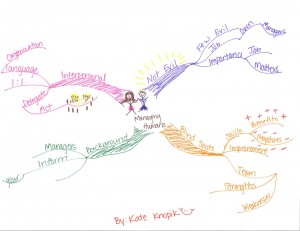
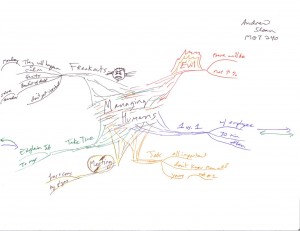
![[Ask]](http://ideamapping.ideamappingsuccess.com/IdeaMappingBlogs/wp-content/plugins/bookmarkify/ask.png)
![[del.icio.us]](http://ideamapping.ideamappingsuccess.com/IdeaMappingBlogs/wp-content/plugins/bookmarkify/delicious.png)
![[Digg]](http://ideamapping.ideamappingsuccess.com/IdeaMappingBlogs/wp-content/plugins/bookmarkify/digg.png)
![[Facebook]](http://ideamapping.ideamappingsuccess.com/IdeaMappingBlogs/wp-content/plugins/bookmarkify/facebook.png)
![[Google]](http://ideamapping.ideamappingsuccess.com/IdeaMappingBlogs/wp-content/plugins/bookmarkify/google.png)
![[MySpace]](http://ideamapping.ideamappingsuccess.com/IdeaMappingBlogs/wp-content/plugins/bookmarkify/myspace.png)
![[Slashdot]](http://ideamapping.ideamappingsuccess.com/IdeaMappingBlogs/wp-content/plugins/bookmarkify/slashdot.png)
![[Sphinn]](http://ideamapping.ideamappingsuccess.com/IdeaMappingBlogs/wp-content/plugins/bookmarkify/sphinn.png)
![[StumbleUpon]](http://ideamapping.ideamappingsuccess.com/IdeaMappingBlogs/wp-content/plugins/bookmarkify/stumbleupon.png)
![[Technorati]](http://ideamapping.ideamappingsuccess.com/IdeaMappingBlogs/wp-content/plugins/bookmarkify/technorati.png)
![[ThisNext]](http://ideamapping.ideamappingsuccess.com/IdeaMappingBlogs/wp-content/plugins/bookmarkify/thisnext.png)
![[Twitter]](http://ideamapping.ideamappingsuccess.com/IdeaMappingBlogs/wp-content/plugins/bookmarkify/twitter.png)
![[Webride]](http://ideamapping.ideamappingsuccess.com/IdeaMappingBlogs/wp-content/plugins/bookmarkify/webride.png)
![[Email]](http://ideamapping.ideamappingsuccess.com/IdeaMappingBlogs/wp-content/plugins/bookmarkify/email.png)

